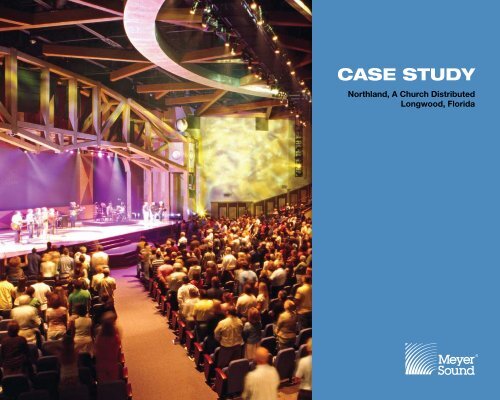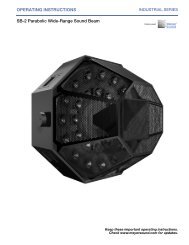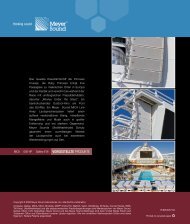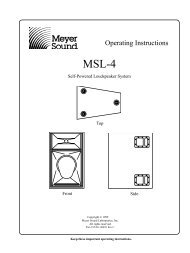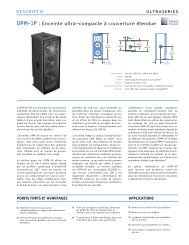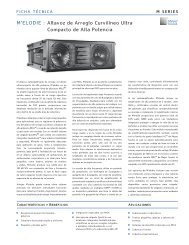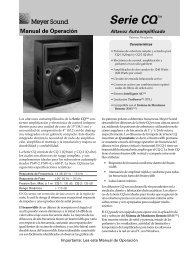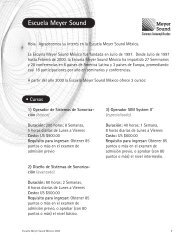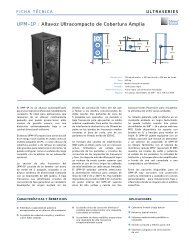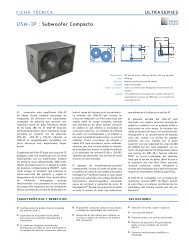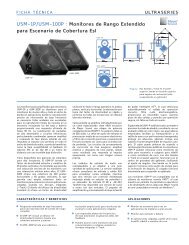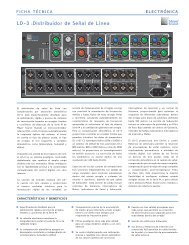Northland Church Case Study - Meyer Sound Laboratories Inc.
Northland Church Case Study - Meyer Sound Laboratories Inc.
Northland Church Case Study - Meyer Sound Laboratories Inc.
Create successful ePaper yourself
Turn your PDF publications into a flip-book with our unique Google optimized e-Paper software.
CASE STUDY<br />
<strong>Northland</strong>, A <strong>Church</strong> Distributed<br />
Longwood, Florida
Constellation at <strong>Northland</strong>,<br />
A <strong>Church</strong> Distributed<br />
Constellation electroacoustic<br />
architecture, part of <strong>Meyer</strong> <strong>Sound</strong>’s<br />
line of digital audio products,<br />
marks a breakthrough in acoustical<br />
design for contemporary houses<br />
of worship. At the touch of a<br />
button, Constellation can tailor the<br />
acoustical characteristics of a room<br />
to achieve the optimal response<br />
for spoken word or any kind of<br />
music. This extraordinary flexibility,<br />
combined with natural sound quality<br />
and a lower cost compared to most<br />
physical or mechanical alternatives,<br />
makes Constellation the preferable<br />
option for churches with a variety<br />
of worship styles, as well as those<br />
hosting concerts featuring a diversity<br />
of traditional and contemporary<br />
concert artists. At <strong>Northland</strong>,<br />
Constellation also encourages<br />
participation through subtle but<br />
effective acoustical enhancement of<br />
congregational singing.<br />
SUMMARY<br />
Audio Environments for a Bold New Vision<br />
The main campus of <strong>Northland</strong>, A <strong>Church</strong> Distributed is situated among the lake-dotted neighborhoods of Longwood,<br />
Florida, about 20 miles from downtown Orlando. However, as the church’s name implies, <strong>Northland</strong> extends beyond one<br />
building in one place. Inspired by the vision of Dr. Joel Hunter, the church’s senior pastor, <strong>Northland</strong> has pioneered the<br />
“networked church”—a visionary concept wherein new media technologies connect churches near and far to enable, in his<br />
words, “sharing people and resources, experiencing common worship services that link up different states, even different<br />
continents.”<br />
Under Dr. Hunter’s leadership, <strong>Northland</strong> has realized both global reach (interactive ”concurrent worship” services have<br />
linked <strong>Northland</strong> with churches as distant as Egypt and Ukraine) as well as burgeoning growth at home. The church<br />
multiplied its ministries by establishing satellite campuses in nearby communities, linking its four sites with high-speed digital<br />
connections. The original Longwood location, a converted roller rink, had been expanded nearly a decade ago to hold 1,200<br />
worshippers; however, even with five worship services each weekend, growing attendance was overflowing the sanctuary.<br />
To accommodate current needs and future growth, in 2007 <strong>Northland</strong> opened a new main campus sanctuary building to<br />
serve as the spiritual and technological hub of its far-reaching ministries.<br />
The leadership at <strong>Northland</strong> established ambitious goals for the new facility and its technology infrastructure. First, the<br />
building’s acoustics and sound system would have to support an exceptionally broad range of worship music styles, ranging<br />
from an acoustic soloist to high-energy rock, and from a bluegrass quartet to a full orchestra with mass choir. Outside of
worship services, the room had to double as a versatile performing arts center for the wider community, hosting not<br />
only touring Christian rock artists but also symphony concerts, ballet performances, and children’s events. Also, the<br />
church leadership wanted the new sanctuary to preserve the sense of a close-knit community, despite holding nearly<br />
three times as many people as the previous space.<br />
These goals are reflected in the design of audio systems at <strong>Northland</strong>. The main reinforcement system is based around<br />
<strong>Meyer</strong> <strong>Sound</strong>’s powerful and extremely accurate MILO line array loudspeakers, and it affords ample power reserves<br />
for effortless reproduction of even the most cutting-edge, youth-oriented Christian artists. At the same time, it carries<br />
the spoken word with extraordinary clarity, carrying even the most subtle inflections of the spoken word throughout<br />
the expansive auditorium.<br />
In addition, <strong>Northland</strong>’s new sanctuary marks the first installation of <strong>Meyer</strong> <strong>Sound</strong>’s Constellation electroacoustic<br />
architecture in a house of worship. With Constellation turned off, the room’s relatively dry natural acoustics support<br />
high-level contemporary music. Then, with a push of a touchscreen button, <strong>Northland</strong>’s audio engineers can select<br />
one of three other acoustical characteristics, with reverberation times ideally suited to various acoustic music styles.<br />
Constellation also enhances congregational singing, encouraging participation and interaction. In addition, with flexible<br />
access to dozens of self-powered loudspeakers distributed around the room, Constellation provides <strong>Northland</strong>’s sound<br />
designers with a powerful tool for sonic creativity in a worship setting.<br />
All photos by Jesse Goff (except where noted otherwise)<br />
Challenges<br />
• A variety of amplified and acoustic worship<br />
music styles<br />
• Very large room seating 3,300<br />
• Congregation accustomed to the “feel” of a<br />
smaller space<br />
• Active congregational participation a critical<br />
part of worship<br />
Requirements<br />
• Provide high intelligibility for sermons,<br />
prayers, and other spoken word elements<br />
• Afford maximum clarity for musical<br />
performances<br />
• Subtly enhance congregational sound, singing<br />
in particular<br />
• Enable instant change of acoustical<br />
characteristics<br />
• Allow Constellation loudspeakers to double<br />
as surround sound/effects system<br />
Benefits<br />
• Room acoustics can be changed with the<br />
push of a button, tailoring the reverberation<br />
characteristics for clarity, envelopment,<br />
intimacy, or warmth.<br />
• Acoustics can be optimized for any music<br />
style, changing even within the same service<br />
• Subtle enhancement of congregational<br />
singing encourages participation<br />
• Constellation loudspeakers over the stage<br />
improve interaction among musicians to<br />
foster better performances<br />
• Lateral and overhead loudspeakers also serve<br />
as a surround sound/effects system
The Constellation system employs a large number of microphones and loudspeakers, the placement and tuning of which are complex and critical. These figures show the loudspeakers deployed in <strong>Northland</strong>’s auditorium.<br />
The system is carefully calibrated to ensure optimal energy levels emanating from every direction.<br />
“It gives me a level of<br />
environmental control that<br />
I’ve never had before. It’s a<br />
creative tool that will offer a<br />
lot of potential for years to<br />
come. It’ll be exciting as we<br />
dive into it even more.”<br />
Todd Herrbach<br />
Senior Audio Engineer<br />
CONSTELLATION SYSTEM OVERVIEW<br />
Constellation electroacoustic architecture combines advanced digital processing and transducer technologies with decades of<br />
research into the acoustical attributes of exceptional listening spaces. Because all acoustical characteristics are configured in the<br />
digital domain, Constellation yields a level of flexibility unattainable with traditional mechanical methods of variable acoustics, such<br />
as movable walls, drapes, temporary orchestra shells, or secondary chambers. Reconfiguration is accomplished at the push of a<br />
button, with no time constraints or labor costs.<br />
At <strong>Northland</strong>, A <strong>Church</strong> Distributed, Constellation enables the staff to customize the natural-sounding acoustics to suit many styles<br />
of worship and a variety of special events. In addition, Constellation has a hardware infrastructure of multizoned, self-powered<br />
loudspeakers that allows the system to accommodate sophisticated surround sound and effects applications.<br />
System Design Goals<br />
First floor seating Balcony seating<br />
From the earliest phases of the building project, the <strong>Northland</strong> leadership team worked closely with noted AV systems consultant<br />
Bill Platt, principal of the Platt Design Group in Sierra Madre, California. The envisioning process outlined the following goals:<br />
• Ensure very high intelligibility for the spoken word, coupled with ample power for a variety of amplified musical presentations<br />
• Provide suitable acoustics for orchestras, choral groups, as well as unamplified ensembles or soloists
• Encourage active participation by the congregation, including singing, by providing the feel of an intimate enclosed space<br />
• Facilitate the creative use of advanced—and even adventurous—sound design techniques in a worship setting<br />
Early on in the discussions, it became apparent that fully implementing the first goal threatened to compromise the second<br />
and third goals. In a room of this size, a relatively dry acoustical characteristic was important to assure high speech<br />
intelligibility and to avoid the harsh, jumbled sounds that can result from amplified contemporary music in an overly<br />
reverberant environment. For the first goal, Platt recommended a fixed physical midband reverberation time of under 1.5<br />
seconds.<br />
Unfortunately, this dry room sound does not work well for most acoustical music presentations, as it robs them of “depth”<br />
and “air.” Simply adding reverberation to the PA mix does not resolve the problem, because the added reverberation stays<br />
inside the directional sound from the front; it is not being generated within the room to fully envelop the audience from all<br />
directions, as would be the case in a naturally reverberant orchestra hall.<br />
Active congregational participation is similarly hampered by dry acoustics. Congregational singing is discouraged when each<br />
congregant seems to be singing alone and not as part of the whole group.<br />
To avoid any compromise on these primary goals, Platt urged <strong>Northland</strong> to implement Constellation electroacoustic<br />
architecture as an integral part of the audio system design.<br />
Ceiling<br />
Constellation<br />
System Configuration<br />
Microphone<br />
MM-4<br />
UPM-1P<br />
UPJ-1P<br />
“It’s a mystery as to why<br />
the ear-brain mechanism<br />
is so powerful. You really<br />
can’t quantify it. But with<br />
Constellation, the possibilities<br />
of tapping into that mystery<br />
are extraordinary. We are<br />
seeing an increasingly<br />
dynamic role for Constellation<br />
in all of our services.”<br />
Tim Tracey<br />
Executive Director of Worship<br />
<strong>Meyer</strong> <strong>Sound</strong> Solution<br />
26 MM-4 loudspeakers<br />
32 UPM-1P loudspeakers<br />
12 UPJ-1P loudspeakers<br />
24 Omnidirectional Constellation<br />
microphones<br />
1 MS-Constellation processor<br />
with VRAS<br />
3 MS-VRAS processors
Project Participants<br />
Facility Owner<br />
<strong>Northland</strong>, A <strong>Church</strong> Distributed<br />
530 Dog Track Road<br />
Longwood, FL 32750<br />
(407) 949-4000<br />
www.northlandchurch.net<br />
Audio Systems: Concept and<br />
Initial Design<br />
Platt Design Group<br />
304 W. Sierra Madre Blvd.<br />
Sierra Madre, CA 91024-2313<br />
(626) 355-0100<br />
www.plattdesigngroup.com<br />
Main Reinforcement System:<br />
Final Configuration and Tuning<br />
Alignment & Design, <strong>Inc</strong>.<br />
204 Falling Leaves Court<br />
Creve Coeur, MO 63141<br />
(314) 651-8021<br />
www.bobmccarthy.com<br />
Audio and Video Systems:<br />
Installations<br />
Electrosonic, <strong>Inc</strong>.<br />
Suite 105, 4501 Vineland Road<br />
Orlando, FL 32811<br />
(407) 839-1154<br />
www.electrosonic.com<br />
RT Settings<br />
Reverb Time [seconds]<br />
4<br />
3.5<br />
3<br />
2.5<br />
2<br />
1.5<br />
1<br />
0.5<br />
63 125 250 500<br />
Frequency [Hz]<br />
1,000 2,000 4,000<br />
Constellation tailors room response in terms of both reverberation time and the frequency content of the reverberant field. As a result, the acoustical<br />
signature of the room can be optimized for the needs of each type of performance or event.<br />
Constellation System Configuration<br />
Long<br />
Medium<br />
Short<br />
Physical Room<br />
Optimal RT Range<br />
Organ, Chant<br />
Romantic Orchestral,<br />
Choir<br />
Opera, Singing,<br />
Recital<br />
Chamber Music<br />
Speech, Theatre<br />
To avoid any semblance of “artificial reverberation,” every Constellation installation is custom designed to blend seamlessly<br />
with the innate physical acoustics of the room. Accordingly, the system must be precisely tailored to the size, shape, surface<br />
dimensions, and materials of the intended venue. Because the sanctuary at <strong>Northland</strong>, A <strong>Church</strong> Distributed was new<br />
construction, the intended use of Constellation was factored into the design of the physical acoustics. In particular, room<br />
design and material treatments limited the inherent room reverberation time to about 1.3 seconds in the midband (average<br />
at 500 Hz and 1 kHz), which is considered relatively dry for a room of this volume.<br />
Constellation Zones<br />
At <strong>Northland</strong>, the Constellation system is laid out in four discrete zones: front, overhead, and mirror-image left and right.<br />
Each zone has its own Constellation VRAS (Variable Room Acoustic System) processor plus a dedicated group of input<br />
microphones and its own complement of <strong>Meyer</strong> <strong>Sound</strong> loudspeakers. Separate zones are essential for realizing natural<br />
reverberation, as the acoustical characteristics will vary with distance from the stage. The zone equipment configurations<br />
at <strong>Northland</strong> are:<br />
Front : Ten overhead loudspeakers (UPM-1P), four lateral loudspeakers (UPJ-1P); six microphones<br />
Left and Right (each): Eight rear loudspeakers (MM-4), six overhead loudspeakers (UPM-1P), four lateral loudspeakers<br />
(UPJ-1P); six microphones<br />
Center: Ten overhead loudspeakers (UPM-1P); six microphones
Constellation Settings<br />
For the purposes of electroacoustic architecture, the Constellation system at <strong>Northland</strong> has three settings plus Off,<br />
allowing the selection of four acoustical room characteristics:<br />
Off: With a midband reverberation time (RT) of about 1.3 seconds, the inherent room acoustics work well for high-level<br />
amplified music, particularly with fast tempos and percussive attacks. Off is also optimum for speech intelligibility.<br />
Short: With a midband RT of 1.7 seconds, the Short setting gives the room a more intimate, enclosed feel. It yields<br />
optimum results for various types of chamber groups and small ensemble instrumentalists. Also, <strong>Northland</strong> engineers<br />
have found this setting works well for the sermon; although not optimum for speech, the extraordinary clarity of the main<br />
PA system maintains excellent intelligibility while Constellation lends the pastor’s voice an “out in the room” presence.<br />
Medium: With a midband RT of 2.2 seconds, this setting is optimized for solo singers and instrumentalists, whether in<br />
worship, recitals or operatic performances.<br />
Long: With a midband RT of 3.0 seconds, this setting works well for romantic orchestral works and large choirs. It also<br />
provides the simulation of a large reverberant space to complement electronically sampled pipe organ sounds, when<br />
desired, as <strong>Northland</strong> does not have a physical pipe organ.<br />
Note that Constellation at <strong>Northland</strong> also offers a Very Long setting. This is not shown in the reverberation time graph as<br />
it is not intended for use as natural electroacoustic enhancement. Rather, it is an extreme setting designed solely for use<br />
as a special effect—a cavernous sound that would not be realistic in the given space.<br />
Frequency Balance<br />
Natural-sounding room reverberation requires balanced response across nearly all of the audible frequency range,<br />
including bass frequencies. Note that in the reverberation graph, the shape of the Constellation-enhanced curves closely<br />
emulates the room’s physical reverberation characteristic, even in the lower frequencies. At <strong>Northland</strong>, these mid-bass<br />
frequencies are supplied by the larger two of the three loudspeaker types: the UPM-1P loudspeaker and the UPJ-1P VariO<br />
loudspeaker. (Use of larger loudspeakers was required because of the extreme width and volume of the room; in smaller<br />
halls, a Constellation system will normally employ smaller loudspeakers with bass augmented by compact subwoofers.)<br />
Special Effects and SpaceMap<br />
When used in the “pure” application as electroacoustic architecture, the Constellation loudspeakers throughout the<br />
room receive input only from the Constellation microphones which are spaced throughout the room to provide natural<br />
regenerative enhancement of the physical room acoustics. However, these same loudspeakers can be accessed for use<br />
as a surround sound or special effects system. At <strong>Northland</strong>, the system is configured to allow the main mixing console<br />
to supply an auxiliary send separately to each of the four Constellation zones. In addition, the Constellation system<br />
incorporates the powerful SpaceMap software program, which allows one or more sound sources to be routed separately<br />
to any one of the discrete outputs of the Constellation system. SpaceMap allows preprogrammed dynamic panning of<br />
sounds to and from any output, enabling the sound designer to freely move sounds anywhere within the space of the<br />
room.<br />
User Interface<br />
Constellation is controlled from the front-of-house mix position via a simple web page interface that is provided by the<br />
Constellation primary processor. Five reverberation time settings, five system gain settings, and the ability to mute and<br />
unmute the stage microphones can be controlled independently. This provides flexibility for use with both acoustic and<br />
reinforced events.<br />
Primary <strong>Sound</strong> Reinforcement<br />
Systems<br />
The main sound reinforcement<br />
system utilizes a total of 36 <strong>Meyer</strong><br />
<strong>Sound</strong> self-powered loudspeakers<br />
to provide highly intelligible,<br />
uniform coverage throughout all<br />
auditorium seating areas. The full<br />
bandwidth response, along with<br />
extraordinary headroom reserves,<br />
makes the system fully suitable<br />
for any type of contemporary or<br />
traditional musical performance.<br />
The system is anchored by MILO<br />
line array loudspeakers, which are<br />
accepted on the riders of nearly<br />
all major touring artists in the<br />
world, Christian or secular.<br />
16 MILO line array loudspeakers<br />
2 CQ-1 loud speakers<br />
2 CQ-2 loudspeakers<br />
6 UPJ-1P VariO loudspeakers<br />
4 UPM-1P loudspeakers<br />
6 M3D-Sub directional subwoofers
“Before the concert, I<br />
thought that the room<br />
could sound good with<br />
classical music as well as<br />
with amplified acts, but I<br />
had no idea it would sound<br />
that brilliant. It was the first<br />
time, but certainly will not<br />
be the last, that we will use<br />
Constellation in a way that<br />
will truly stun the audience.”<br />
Marc McMurrin<br />
Executive Director of Operations<br />
<strong>Northland</strong>, A <strong>Church</strong> Distributed<br />
Installation, Calibration, and Tuning<br />
Prior to installation of any audio systems at <strong>Northland</strong>, the <strong>Meyer</strong> <strong>Sound</strong> Constellation team took precise measurements to<br />
determine the fixed acoustical parameters of the room. Using this characteristic as a foundation, the Constellation team then<br />
determined the numbers and precise placement for both loudspeakers and microphones. Since Constellation features both<br />
regenerative and in-line components, system design, especially component placement, is complex and critical. However, actual<br />
installation of the system requires only best-practice professional installation skills and attention to detail in conforming to the<br />
design. No special tools or proprietary techniques are involved.<br />
Once the installation of fixed components was complete, the <strong>Meyer</strong> <strong>Sound</strong> Constellation team returned to calibrate and tune the<br />
system, as well as generate the presets. As with the design of a Constellation system, the calibration and tuning stage involves<br />
complex procedures requiring highly trained and experienced staff. The Constellation team conducted these processes using<br />
proprietary methods and powerful tools, including <strong>Meyer</strong> <strong>Sound</strong>’s own SIM 3 audio analyzer. At the conclusion of the tuning<br />
process, standard measurements, replicable by any acoustical professional, were taken to confirm that the stated design goals<br />
had been achieved.<br />
The Outcome<br />
A Foundational <strong>Sound</strong><br />
After the sanctuary was first opened in August 2007, the audio staff immediately began an exhaustive experimentation and<br />
review process to determine how best to apply the power of Constellation to the varied programming heard at <strong>Northland</strong>,<br />
both during worship and at special events. After several months of careful listening and in-house consultation, a consensus<br />
emerged that the Short setting of Constellation would serve as the base sound of the room, as it provides the degree of “aural<br />
interconnectedness” desired for the sense of a close-knit group in a common space. Constellation is only turned completely off<br />
when necessary for very high energy, up-tempo amplified music.
Audio Director Steve Groves says, “The clarity of the main PA is so good that adding in Constellation doesn’t impair<br />
intelligibility. It just gives a better feel to the room.”<br />
Adapting to Any Musical Style<br />
Though interwoven with a common spiritual thread, the musical styles heard at <strong>Northland</strong> are astonishingly diverse. A single<br />
worship service can move effortlessly between folk, classical, soul/R & B, rock, and various ethnic-influenced styles. With<br />
Constellation, each can receive the optimum acoustical setting—with changes sometimes accomplished between successive<br />
songs.<br />
Steve Groves relates a typical example. “A couple weeks ago, we started out with an up-tempo praise song, then went into<br />
an a capella arrangement of “Amazing Grace”, and after that straight into another up-tempo song. During “Amazing Grace,”<br />
I reached over to the touchscreen and put Constellation into the Long setting, to give it a larger, more traditional sound, and<br />
really let the congregation hear themselves,” he says. “When they hit the last note, I went back to the Short setting.”<br />
Tim Tracey, <strong>Northland</strong>’s executive director of worship, recalls one memorable introduction to Constellation’s unique<br />
capability. “We were rehearsing a bluegrass gospel song, “Get Up John,” at first just through the main PA. Then we turned<br />
on Constellation, and it was amazing,” he says. “All of a sudden we had much more air in the acoustic instruments and<br />
vocals.”<br />
The Core of Community Worship<br />
The use of Constellation has proven extraordinarily effective in promoting congregational participation by creating an<br />
unmistakable sense of aural involvement of the entire worshipping community.<br />
“A congregation isn’t passive like the audience in a theater or a concert hall,” emphasizes Tim Tracey. “Worshippers play a<br />
vital, active role. We needed to create an environment that connects them to each other and encourages participation, and<br />
Constellation supports that through sound.”<br />
Tools for Unlimited Creativity<br />
<strong>Northland</strong> is known for its passionate commitment to creativity, and Constellation’s technology infrastructure has given the<br />
church’s audio staff new possibilities for applying imaginative sound design to worship.<br />
“The PA is mono, but with Constellation I can also use the top, side, rear, and front zones independently as the music calls<br />
for,” remarks Greg Weiss, audio engineer and sound designer. “I can move sounds around, envelop the audience, or come<br />
from behind or above. It can be a pad or synth bed, or maybe vocals wrapping around, or perhaps raining down like a<br />
waterfall from the ceiling. But it’s always subtle and tasteful, and fits the overall environment of what we are doing.”<br />
Tim Tracey recalls one striking example: “We did one song where we turned the main PA off and mixed all the sound<br />
entirely in the Constellation system loudspeakers. It was a dissonant vocal called ”Over Oceans,” and we wanted to illustrate<br />
the hidden harmony in what seems like dissonance,” he says. “The song was strong on its own, but Steve propelled it to a<br />
whole other level with the dynamic mix he did all around the room. It was one of the most effective things we’ve ever done<br />
in worship.”<br />
About <strong>Northland</strong>,<br />
A <strong>Church</strong> Distributed<br />
<strong>Northland</strong>, A <strong>Church</strong> Distributed<br />
has been a pioneer in<br />
building a networked, multicampus<br />
church. With four<br />
central Florida locations and<br />
the total number of weekly<br />
worshippers of over 12,000,<br />
<strong>Northland</strong> decided to build<br />
a new 3,300-seat facility to<br />
accommodate the congregants,<br />
replacing the original space in<br />
Longwood that was previously<br />
converted from a roller<br />
rink. Known for leveraging<br />
digital AV technology to<br />
unite the worshippers in<br />
the different sanctuaries,<br />
<strong>Northland</strong> adopted the most<br />
advanced technologies in<br />
the new building to create a<br />
supportive environment for the<br />
worshippers.
“I was frankly amazed at<br />
how well the [Constellation]<br />
system worked. What I found<br />
particularly impressive is how<br />
I could maintain a clear sense<br />
of the origination of different<br />
instruments at various places<br />
around the stage.”<br />
Douglas Adams<br />
President<br />
Dallas Symphony Orchestra<br />
Constellation Makes Dallas Symphony Orchestra Feel At Home<br />
During an acclaimed concert of the Dallas Symphony Orchestra led by Guest Conductor and Violinist Pinchas Zukerman,<br />
<strong>Northland</strong> was successfully transformed into a concert hall, providing the optimal acoustical environment for the audience<br />
to revel in the musical masterpieces of Stravinsky and Schumann. With the physical characteristics of <strong>Northland</strong>’s room<br />
optimized for amplified music, the success of the Dallas Symphony concert is notable, and made an impression on Mark<br />
Melson, the symphony’s vice president of artistic operations.<br />
“I was worried when I first walked into the building,” confesses Melson, after seeing the vast, wide room, “but my worries<br />
ended when the musicians started playing. The orchestra retained its natural warmth and presence at seats well out into<br />
the hall.”<br />
The sound quality during the event was certainly appreciated by the audience—including Dallas Symphony President<br />
Douglas Adams. “I was frankly amazed at how well the [Constellation] system worked,” says Adams. “What I found<br />
particularly impressive is how I could maintain a clear sense of the origination of different instruments at various places<br />
around the stage. Each was perceived in its proper place, as it would be with natural acoustics.”<br />
With the goal to provide a familiar acoustical environment for the performers onstage, <strong>Meyer</strong> <strong>Sound</strong>’s Constellation team<br />
created a customized setting of early decay time (EDT) and reverberation time (RT) that closely emulate measurements at
the Dallas Symphony’s acoustically impeccable home, the Morton H. <strong>Meyer</strong>son Center. The resulting system had an<br />
RT of 2.4 seconds and an EDT of 1.9 seconds, very close to the <strong>Meyer</strong>son measurements of 2.6 seconds RT and<br />
1.9 seconds EDT.<br />
Using only Constellation without reinforcement from the main PA system, the Dallas Symphony orchestra was<br />
reported to be an “eye- and ear-opening” experience for the church. “Before the concert, I thought that the<br />
room could sound good with classical music as well as with amplified acts, but I had no idea it would sound that<br />
brilliant,” says Marc McMurrin, executive director of operations at <strong>Northland</strong>. “It was the first time, but certainly will<br />
not be the last, that we will use Constellation in a way that will truly stun the audience.”<br />
Tim Tracey, <strong>Northland</strong>’s executive director of worship, adds that the success of the symphony event has renewed<br />
the church’s vision to serve the community with expanded offerings. “Since the Dallas event, our phone has been<br />
ringing off the hook with groups interested in using our facility, and our new task is to determine how to best use<br />
this space, in keeping with our congregation’s mission.” One of <strong>Northland</strong>’s plans is to arrange opportunities for<br />
nurturing young local musicians, including potential collaborations with a youth orchestra.<br />
Photos this and previous page: Jeff Hawkins (jeffhawkins.com)<br />
A Multipurpose Venue<br />
for the Community<br />
The Constellation system has<br />
helped position <strong>Northland</strong> as a<br />
viable alternative performance<br />
space as it attracts worldrenowned<br />
artists, and has<br />
allowed the sanctuary to reach<br />
out to the local community.<br />
Artists who have performed<br />
at <strong>Northland</strong> include Florida<br />
Youth Symphony Orchestra, the<br />
Kiev Symphony Orchestra and<br />
Chorus, country star Wynonna,<br />
gospel music singer Kirk<br />
Franklin, and contemporary<br />
Christian artist Michael W. Smith.<br />
“Our senior pastor, Joel Hunter,<br />
refers to our new building as<br />
‘a communication device with a<br />
sanctuary attached,’” says Marc<br />
McMurrin, <strong>Northland</strong>’s executive<br />
director of operations. “Having<br />
the technology to present<br />
symphonic music gives us a<br />
great tool for communication,<br />
one that helps us in our<br />
mission to serve the whole<br />
community.”
WORLDWIDE OFFICES<br />
<strong>Meyer</strong> <strong>Sound</strong> Headquarters<br />
2832 San Pablo Avenue<br />
Berkeley, Calif., 94702<br />
USA<br />
T: +1 510 486.1166<br />
F: +1 510 486.8356<br />
sales@meyersound.com<br />
www.meyersound.com<br />
<strong>Meyer</strong> <strong>Sound</strong> Nashville<br />
T: +1 615 244.2472<br />
nashville@meyersound.com<br />
<strong>Meyer</strong> <strong>Sound</strong> Australia Pty Ltd.<br />
T: +61 7 3252.4433<br />
F: +61 7 3252.3380<br />
australia@meyersound.com<br />
www.meyersound.com.au<br />
<strong>Meyer</strong> <strong>Sound</strong> Belux<br />
T: +32 2 567.2710<br />
F: +32 2 567.2709<br />
belux@meyersound.com<br />
<strong>Meyer</strong> <strong>Sound</strong> Brazil<br />
T: +55 11 3816.0401<br />
brazil@meyersound.com<br />
Copyright © 2009 <strong>Meyer</strong> <strong>Sound</strong> <strong>Laboratories</strong>, <strong>Inc</strong>. All rights reserved.<br />
<strong>Meyer</strong> <strong>Sound</strong> Canada<br />
T: +1 250 549.2558<br />
F: +1 250 549.2668<br />
canada@meyersound.com<br />
<strong>Meyer</strong> <strong>Sound</strong> CIS<br />
T: +7 095 943.0091<br />
F: +7 095 947.9140<br />
russia@meyersound.com<br />
<strong>Meyer</strong> <strong>Sound</strong> España S.A.<br />
T: +34 90 216.0245<br />
F: +34 90 018.0762<br />
spain@meyersound.com<br />
<strong>Meyer</strong> <strong>Sound</strong> Lab. Germany GmbH<br />
T: +49 2602 99908.0<br />
F: +49 2602 99908.99<br />
germany@meyersound.com<br />
www.meyersound.de<br />
<strong>Meyer</strong> <strong>Sound</strong> México<br />
S. de R.L. de C.V.<br />
T: +52 55 5631.8137<br />
F: +52 55 5630.5391<br />
mexico@meyersound.com<br />
www.meyersound.com/spanish<br />
<strong>Meyer</strong> <strong>Sound</strong> Portugal<br />
T: +351 91 512.8686<br />
portugal@meyersound.com<br />
<strong>Meyer</strong> <strong>Sound</strong> UK Ltd.<br />
T: +44 7887.777150<br />
uk@meyersound.com<br />
18.990.230.06 A<br />
Ensemble, SIM, Stella, VariO, VoiceLift, VRAS, and all alphanumeric product designations are trademarks of <strong>Meyer</strong> <strong>Sound</strong>. Constellation,<br />
<strong>Meyer</strong> <strong>Sound</strong>, and the <strong>Meyer</strong> <strong>Sound</strong> wave logo are registered in the United States Patent and Trademark Office, as well as in other countries.<br />
All third-party trademarks mentioned herein are the property of their respective owners. Patents pending. Printed on recycled paper


